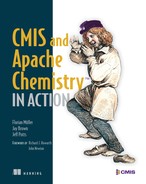About this Book
The OASIS CMIS (Content Management Interoperability Services) standard is the lingua franca of Enterprise Content Management (ECM) systems. This book is a comprehensive guide to the CMIS standard and related ECM concepts.
The focus of this book is on hands-on experience with the standard and with the Apache Chemistry libraries and tools. We start with providing the basics for developers, but these early chapters will also be beneficial for nondevelopers who want to understand the standard. As you get deeper into the book, by the end of part 2, you should be able to build an application that connects to any content repository that supports CMIS. We provide practical code examples for Java, Groovy, Python, C#, Objective-C, PHP, and JavaScript. And in the final chapters, we cover expert topics like optimizing your CMIS application and building your own CMIS server.
Audience
This book was written primarily for software developers and architects who design and build content-centric applications. You don’t have to be an ECM expert to follow along, but some familiarity with content management systems is assumed. Basic programming skills will be useful for the first part of this book. Parts 2 and 3 require knowledge of a standard programming language like Java or C#, but no previous CMIS expertise or knowledge of the Apache Chemistry libraries are required.
Roadmap
This book is divided into three parts, each with a different target audience with respect to experience level.
Part 1 (chapters 1–5) is for newcomers to ECM and CMIS. The examples in this section are very simple and cover a broad spectrum of CMIS operations at a basic level.
Part 2 (chapters 6–10) is for a more intermediate audience, who at a minimum are comfortable with the CMIS basics covered in part 1 and have a bit more application development background. Part 2 is where you’ll build a functioning content-centric application with CMIS. You’ll notice a distinct increase in pace when you get into part 2, especially by the time you get to chapter 7.
Part 3 (chapters 11–14), as well as some of the appendix material, is for an advanced audience, with some of the material aimed at lead developers or architects. This part covers low-level details around the CMIS bindings, security, and performance, and also covers how to implement your own CMIS-compliant server.
Code conventions and downloads
All source code in listings or in text is in a fixed-width font like this to separate it from ordinary text. Code annotations accompany many of the listings, highlighting important concepts. In some cases, numbered bullets link to explanations that follow the listing.
You can download the source code for all listings from the Manning website, www.manning.com/CMISandApacheChemistryinAction.
Author Online
The purchase of CMIS and Apache Chemistry in Action includes free access to a private web forum run by Manning Publications, where you can make comments about the book, ask technical questions, and receive help from the authors and from other users. To access the forum and subscribe to it, point your web browser to www.manning.com/CMISandApacheChemistryinAction. This page provides information on how to get on the forum once you are registered, what kind of help is available, and the rules of conduct on the forum.
Manning’s commitment to our readers is to provide a venue where a meaningful dialogue between individual readers and between readers and the authors can take place. It is not a commitment to any specific amount of participation on the part of the authors, whose contribution to the forum remains voluntary (and unpaid). We suggest you try asking the authors some challenging questions lest their interest stray!
The Author Online forum and the archives of previous discussions will be accessible from the publisher’s website as long as the book is in print.
